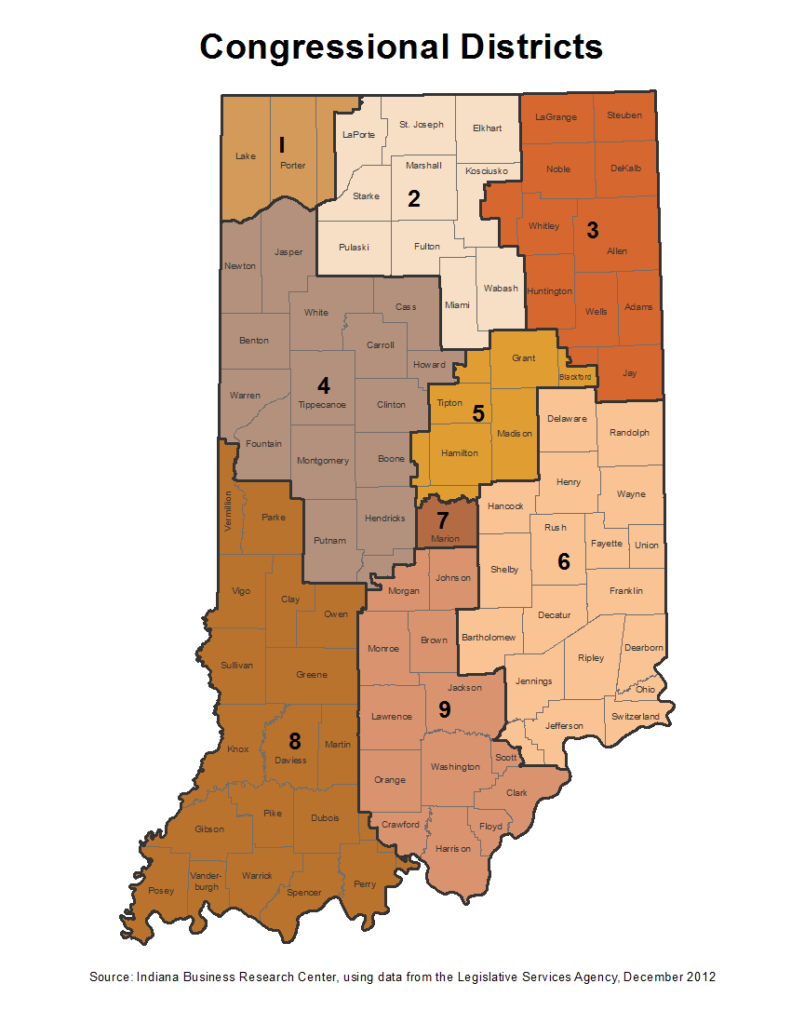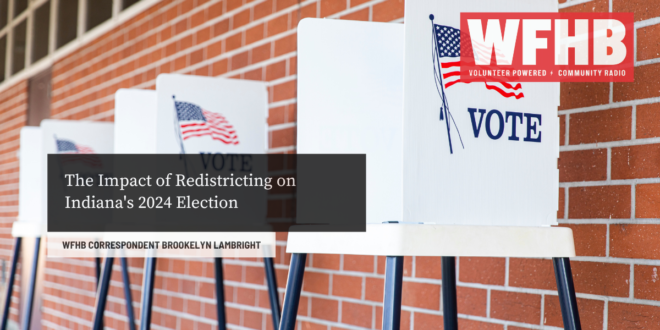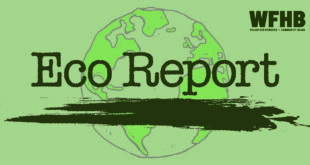Podcast: Play in new window | Download (Duration: 11:53 — 10.9MB)
Subscribe: RSS
Common Cause Indiana, a nonprofit organization advocating for redistricting reform discusses the impact of severe gerrymandering across the state.
In Indiana, the legislative maps used to divide Hoosiers into voting districts are more biased towards one party than 95% of maps drawn in other U.S. states. What is expected to be a fair process meant to encourage voter turnout and strengthen minority voters has become a process known as gerrymandering.
Every ten years, new legislative maps are drawn to adjust for fluctuations in population. However, the practice has become an opportunity for politicians across the board to secure a majority win for their party. The last redistricting map was drawn in 2021 meaning the next redraw is in 2031.

Julia Vaughn, the Executive Director of Common Cause Indiana, a nonprofit organization which lobbies for accountable and honest government, proposes a law reform which prohibits gerrymandering entirely.
“Unfortunately, what happens, particularly when you have politicians leading the process, is politics takes over. So we think you need to spell out in law, that you cannot draw these districts to benefit a political party or to benefit any individual person. And that’s how you stop gerrymandering because that gives you a big tool. If you know the districts don’t do that, that gives you a tool to go to court and hold whoever drew the maps accountable for not following that principle. We need not only a different set of people to control the redistricting process, but we also need some language in state law that says whoever draws the maps can’t gerrymander,” said Vaughn.
There are a few guidelines Indiana redistricting has to follow. The first being that each district must be equally populated. This follows the principle that one person equals one vote. The next is that districts must comply with the Voting Rights Act, meaning districts must expand on the strength of minority voters rather than splitting minority votes to dismantle their voting power. Indiana’s constitution also requires that districts are contiguous, meaning they must touch.
In 2015, Common Cause Indiana joined with the League of Women Voters Indiana to create the All IN for Democracy Coalition made up of 33 organizations across the state to raise awareness about and combat redistricting.
The All IN for Democracy Coalition held a mapping competition in 2021. A committee made up of three Democrats, three Republicans, and three Independents held 10 hearings to understand what Hoosiers thought state districts should look like. Hoosiers across the state were then encouraged to create fair district maps for that year’s redistricting cycle. Contestants were able to use Districtr, a publicly available software with data about Indiana’s communities. The submitted maps were judged by the politically impartial committee and the fairest map was selected.
While the winning map was not approved by Indiana’s General Assembly, Vaughn says the mapping competition raised awareness about redistricting across the state.
“So, while we weren’t able to convince the Indiana General Assembly to adopt the maps that won our competition, back in 2021, our coalition certainly did a great job at turning people out to the statehouse to testify on the issue […] So, you know, we’re very proud to lead the effort to set an example of how this should be done, and also to help Hoosiers make their voices heard on the maps that were adopted back in 2021,” said Vaughn.
Getting reform surrounding gerrymandering is difficult in states like Indiana where one party holds a majority of the power in the statehouse. Indiana also lacks a ballot initiative process which would place a citizen-proposed measure directly on the ballot.
“It’s really tough to get reform of redistricting in a state like Indiana where we don’t have the ballot initiative process. I want to emphasize that many states are redistricting differently or did it differently in 2021. For example, Michigan had a citizen’s commission that we actually borrowed a lot of the model for the commission we created here in Indiana, but in Michigan, they were able to effect this change because they have a ballot initiative process. Volunteers went out, they collected a certain number of signatures to qualify for the ballot, and then Michiganders were able to vote directly. Republicans, Democrats, Libertarians, Independents, most voters recognize that gerrymandering, it’s just wrong, and is anti-democratic, and if we had the ability to vote on it directly here in Indiana, I have no doubt that we could pass reform,” said Vaughn.
Women4Change, an organization that provides civic learning and advocates for better outcomes in health, economic stability and personal safety for women in Indiana, commissioned a study of Indiana’s redistricting practice in 2011. Conducted by Christopher Warshaw, the Associate Professor at George Washington University, the study found that the 2011 redistricting plan in Indiana had a “substantial bias in favor of Republicans”. Republicans won 54.2% of the statewide vote in 2012 but held 78% of Indiana’s congressional seats. Warshaw also found that even if the statewide vote changed by five percentage points in either direction politically, the efficiency gap, or ratio of wasted votes by each party, would still be largely in favor of Republicans.
“Moreover, the level of bias in 2012 was more extreme than 86% of previous elections and more pro-Republican than 91% of previous U.S. congressional elections over the past 45 years,” wrote Warshaw in the study.

Since the redistricting in 2011, Vaughn says voters have begun to notice a gap between themselves and their legislators. Gerrymandering allows for extreme politicians to get elected despite a mostly moderate electorate.
“We’re really proud that there’s a far greater understanding now in Indiana about how impactful redistricting is. In the previous cycles that I’ve participated in back in 2001 and 2011, I don’t think there was really the awareness that exists now. I think one reason is that Indiana has passed some pretty radical laws over the past several years. The first one, I think that caught our members’ attention was the Religious Freedom Restoration Act. When that passed, I think a lot of people thought to themselves, ‘That’s, that’s not a priority for me. That’s not something I think the General Assembly needed to pass into law. Why is this elected General Assembly so much more conservative than me and my neighbors?’ And there have been other issues, certainly the abortion ban, corporate welfare, issues involving public safety, all sorts of issues. I think people are now understanding that our legislature isn’t really representative of many voters across our state because the lines have been rigged,” said Vaughn.
Politicians often use a technique called cracking and packing when drawing new districts. Packing involves placing voters with similar political interests into as few districts as possible. Cracking splits voters with similar political interests into multiple districts in hopes it will lessen their ability to elect their preferred candidate. By using these techniques, politicians are strategically picking voters to predict the outcome of state legislative elections.
These techniques often affect communities of color the most. Because communities of color often elect left-leaning candidates, conservative politicians pack more liberal, diverse communities into the smallest number of districts as possible.
“Here in Indiana, because most of our communities of color live in just a few urban areas, gerrymandering often carves those communities up. So, they really can’t flex their political muscle. They can’t make their voice fully heard as strongly as it should be, because their communities have been sliced and diced and put into districts,” said Vaughn.
Gerrymandering also impacts voter turnout. Voters who never see their preferred candidate get elected may give up on voting entirely.
“We hear time and again, people say, ‘Why should I bother? My candidate is not going to win anyway.’ That’s a hard thing to rebut. So, I think voter turnout and election issues are complicated and it’s never just one thing. But again, I think gerrymandering is the single biggest reason for our poor participation here in Indiana,” said Vaughn.
Common Cause Indiana’s proposed solution to unfair redistricting is an independent Citizens Redistricting Commission. New maps would be drawn by a multi-partisan and diverse committee that best reflects the state’s citizenry.
“As long as legislators control the process, they are not going to draw districts for voters, they’re going to draw districts for politicians. So, if we want districts drawn for voters, then we’ve got to have voters actually drawing the districts,” said Vaughn.
For more information on Common Cause Indiana and redistricting in Indiana, visit commoncause.org. Vaughn encourages voters to sign up for “action alerts” which notify recipients on updates from Indiana’s statehouse. For voters looking to take action, Vaughn says reaching out to state representatives regarding redistricting is best done when the legislature is not in session.
As Vaughn said, “Reforming the system could mean a whole new day for democracy in Indiana.”
 WFHB Bloomington Community Radio
WFHB Bloomington Community Radio


